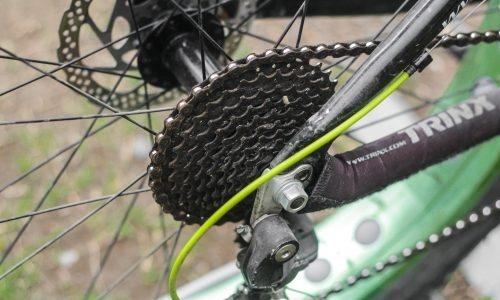SRAM is one of the leading groupset brands on the market, alongside Shimano and Campagnolo. On the entry-level end sits SRAM’s Apex groupset, which is comparable to Shimano’s Tiagra groupset.
The Apex is followed up by the SRAM Rival, which got its name as it is seen by SRAM as a rival to Shimano’s popular 105 groupset.
Above the Apex and Rival groupsets is the SRAM Force, which is similar to the Shimano Ultegra and just below the Shimano Dura-Ace. At the top of the pile is the newest groupset, the Red eTap, which is the lightest and most expensive
SRAM’s range uses a feature called ‘DoubleTap’, which is basically a single gear level on each which does both up and down shifting.
One click on the left lever results in you moving onto the smaller chainring. A longer push moves you onto the bigger chainring (this doesn’t apply to the 1x ranges).
On the right hand side, a short push moves you into a smaller cog for more resistance, while a longer push results in a bigger cog and less resistance.
SRAM Apex
As mentioned above, the SRAM Apex is the entry-level option in the SRAM range. In terms of performance, it is similar to Shimano’s Tiagra groupset.
However, the notable difference between the Apex and the rest of the range is that it is a 10-speed groupset. That means the jumps between gears are a bit more noticeable.

The Apex comes with an available chainset/crankset of 53/39, 50/34 and 48/35. The good news is you can still opt for a 11-32 cassette because of the availability of the WiFLi rear derailleur and the 1x lineup.
SRAM’s WiFli system provides a wider gear range – it can actually go up to 36t for the rear cog. This system gives SRAM the fairly unique ability to have more gears on one chainring, rather than the more common triple chainring setup.
There is an 1×11 gearing option of the Apex, called the Apex 1. Basically, it’s one chainring at the front and 11 gears at the rear, but it does allow up to a 42t cog.
Main characteristics of SRAM Apex:
- Good spread of gears
- Relatively light
- Inexpensive
Read more about the SRAM Apex groupset at their official website.
You can find SRAM Apex components on Amazon.com
SRAM Rival
Above the Apex is the SRAM Rival, which can also use the WiFli rear derailleur and cassette system. However, the Rival is made of lighter materials than the Apex. As with Shimano’s 105 groupset, the Rival is the most popular in the SRAM range for road bikers.
The Rival is an 11-speed groupset, with a more commonly used 2×11 chainring set up. You can, however, get the Rival with just one chainring – 1×11.

The Rival is a more modern creation from SRAM and features more modern technology, as well as revamped DoubleTap levers as well as bigger shift paddles.
The Rival shares a lot more in common with the more expensive groupsets than the Apex, including 22 gears, options for hydraulic disc brakes, and the comfortable ErgoFit shift/brake lever design.
Unlike the more expensive options, the Rival does, however, come with aluminium materials instead of carbon, making it heavier.
Main characteristics of SRAM Rival:
- Solid performance across the board
- Better braking
- More gear options
See more about the SRAM Rival here.
Find SRAM Rival components on Amazon.com or Planetcyclery.com
The main differences
There are a few key differences between the two groupsets. When it comes to braking, the Apex comes with one brake system, which is actually pretty effective.
The Rival comes with two brake systems that also perform pretty well. Both options can be adapted for hydraulic brakes but the Rival is more compatible.
The shifters are similar. They are both nice and easy, although the Rival is a little bit more uncomfortable, although it is also more precise. The Apex crankset is fairly basic. You can choose between two different sized chains.
The Rival, however, is a more comfortable ride and offers far more control of speed. The Rival groupset, as a mid-range groupset, does come with superior shifting. It’s much sharper and faster than the Apex. The Apex also appears slightly less robust.
The two groupsets don’t have much apart in terms of weight, for most cyclists the difference is minimal. As expected, when it comes to price, the Rival is slightly more expensive than the Apex. The difference isn’t huge though. Both would sit in the affordable range.
Overview
While both perform well on the road, the Rival is built with better materials and has more gears for extra speed and to get up hills easier.
The Apex is a great option for anyone looking for reliable performance with plenty of value, but the Rival is more appealing as a mid-range groupset with good performance across the board.
Particularly when used for long cycles, the Apex performance doesn’t hold the same as much as the Rival, but then you get what you pay for.

Founder of Vivi Nation, the cycling, running and active living brand. Chris is a sports enthusiast, occasional triathlete and experienced cyclist, having led multiple cycle tours across Europe.


